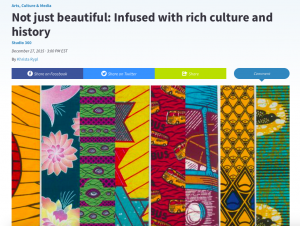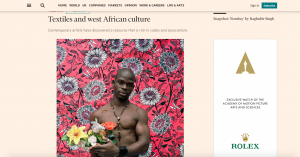Paulicelli, E. and Clark, H. (2009) The Fabric of Cultures. Abingdon: Routledge.
I went to the WSA library and picked up this book which explores cultural case studies in fashion and how culture shapes the identities of each nations and cities. The book contains images of different styles across the world, from fustanella in Greece to the art of dressing in Soviet Russia in the 50s and 60s.

Rypl, K. (2015) Not just beautiful: Infused with rich culture and history. Available from:
https://www.pri.org/stories/2015-12-27/these-beautifully-colored-textiles-have-been-infused-rich-history-and-culture [Accessed 28 October 2017]
I took the internet to further my research and came across this article about African textile. The rich coloured fabric featured in the article were products of a dutch company called ‘Vlisco’ which were designed and produced in Netherlands. Vlisco have remained popular in Africa since the 1800s, this is due to their design in which they keep in mind for each countries, creating specific cultural meanings. Scrolling through the prints, one of my favourite piece is the “Fan Ventilateur” this print really catches your attention with the use of bright colours contrasting with black outlines, the patterns create an illusion in the eye creating vibrations.

Le Brun, L. (2016) Textiles and west African culture. Financial Times, 24 June.
Lastly, this article on Financial Times looks into contemporary artists discussing the ways in which they use textiles. Yinka Shonibare explains how he is “fascinated by the cultural confusion” and why he chooses his fabrics carefully. Malian artist Abdoulaye Konaté mentions how he started using cloth in his work.

